FORD KUGA 2010 1.G Owners Manual
Manufacturer: FORD, Model Year: 2010, Model line: KUGA, Model: FORD KUGA 2010 1.GPages: 226, PDF Size: 8.07 MB
Page 141 of 226
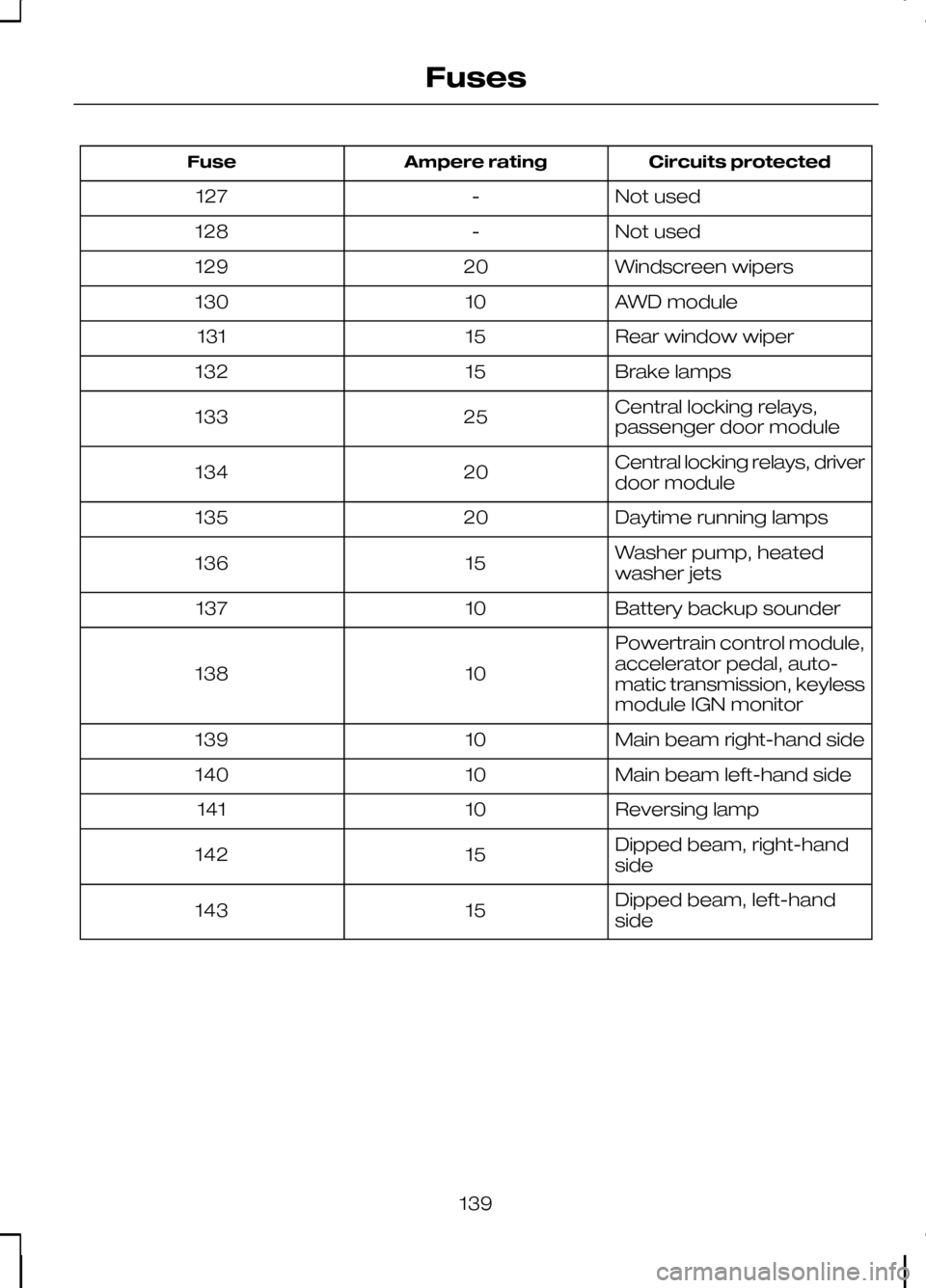
Circuits protected
Ampere rating
Fuse
Not used
-
127
Not used
-
128
Windscreen wipers
20
129
AWD module
10
130
Rear window wiper
15
131
Brake lamps
15
132
Central locking relays,
passenger door module
25
133
Central locking relays, driver
door module
20
134
Daytime running lamps
20
135
Washer pump, heated
washer jets
15
136
Battery backup sounder
10
137
Powertrain control module,
accelerator pedal, auto-
matic transmission, keyless
module IGN monitor
10
138
Main beam right-hand side
10
139
Main beam left-hand side
10
140
Reversing lamp
10
141
Dipped beam, right-hand
side
15
142
Dipped beam, left-hand
side
15
143
139
Fuses
Page 142 of 226
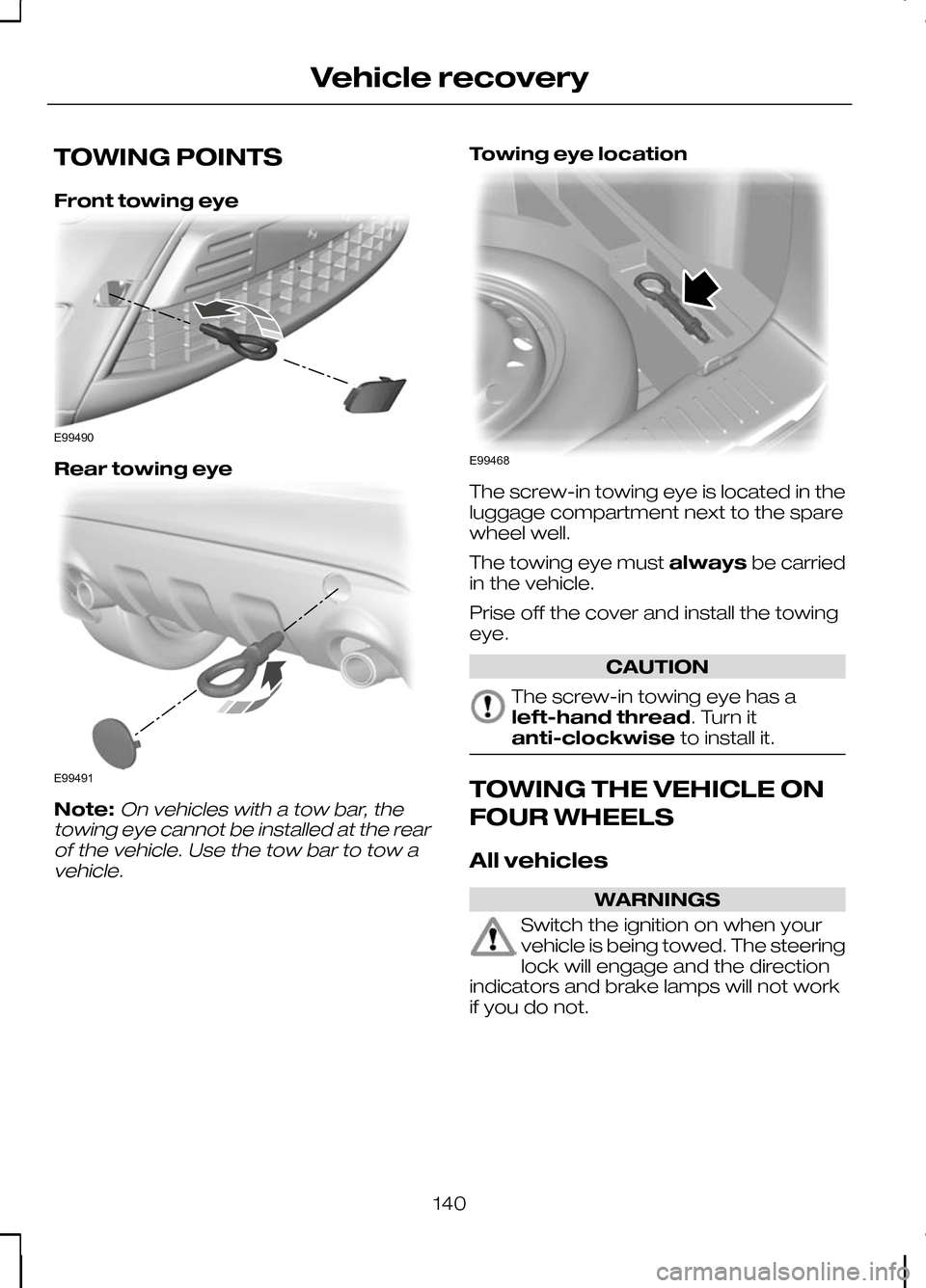
TOWING POINTS
Front towing eye
Rear towing eye
Note:On vehicles with a tow bar, the
towing eye cannot be installed at the rear of the vehicle. Use the tow bar to tow avehicle.
Towing eye location The screw-in towing eye is located in the
luggage compartment next to the spare
wheel well.
The towing eye must
alwaysbe carried
in the vehicle.
Prise off the cover and install the towing
eye. CAUTION
The screw-in towing eye has a
left-hand thread. Turn it
anti-clockwise
to install it. TOWING THE VEHICLE ON
FOUR WHEELS
All vehicles
WARNINGS
Switch the ignition on when your
vehicle is being towed. The steering
lock will engage and the direction
indicators and brake lamps will not work
if you do not.
140
Vehicle recoveryE99490 E99491 E99468
Page 143 of 226
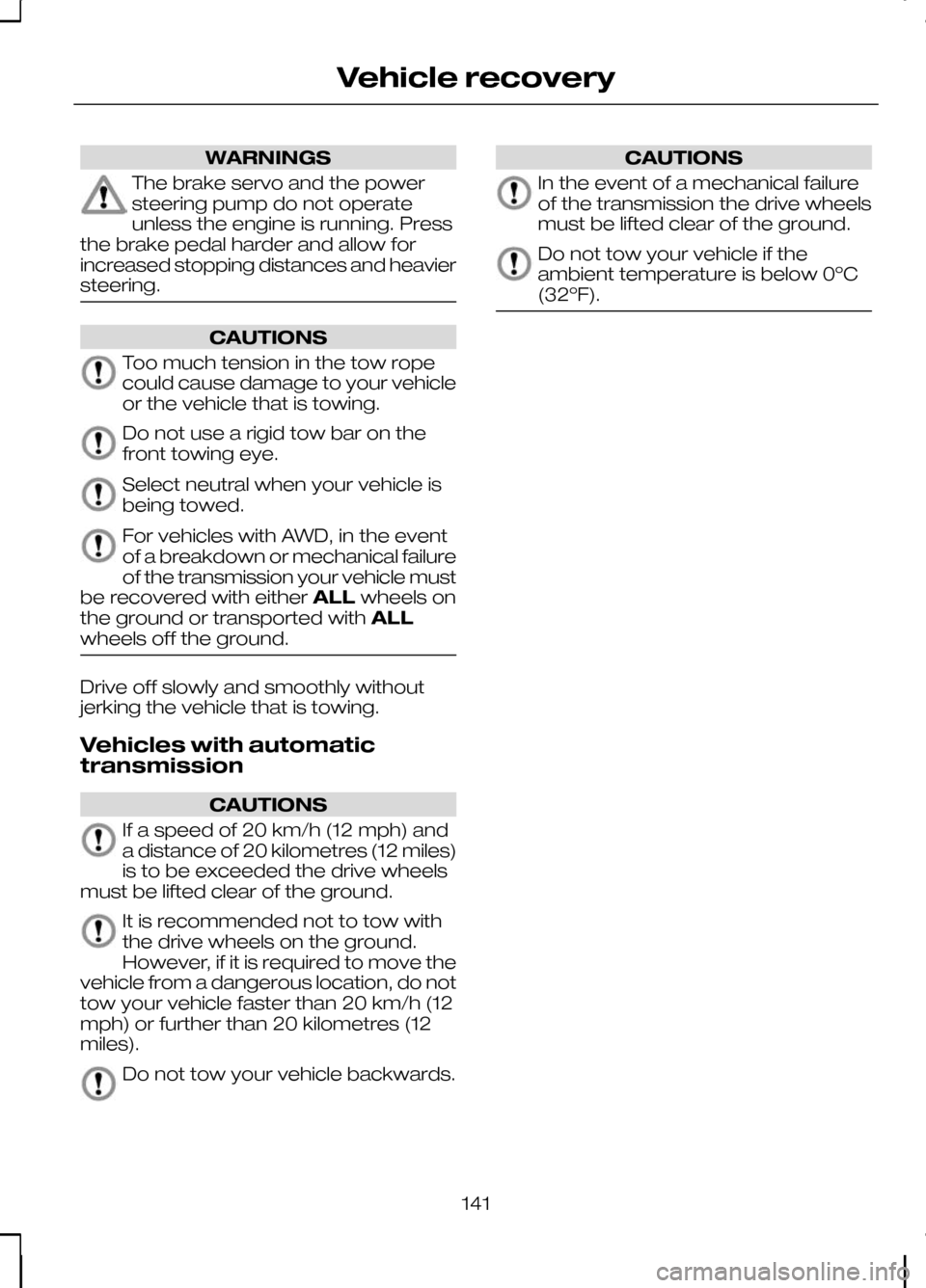
WARNINGS
The brake servo and the power
steering pump do not operate
unless the engine is running. Press
the brake pedal harder and allow for
increased stopping distances and heavier
steering. CAUTIONS
Too much tension in the tow rope
could cause damage to your vehicle
or the vehicle that is towing.
Do not use a rigid tow bar on the
front towing eye.
Select neutral when your vehicle is
being towed.
For vehicles with AWD, in the event
of a breakdown or mechanical failure
of the transmission your vehicle must
be recovered with either ALLwheels on
the ground or transported with ALL
wheels off the ground. Drive off slowly and smoothly without
jerking the vehicle that is towing.
Vehicles with automatic
transmission
CAUTIONS
If a speed of 20 km/h (12 mph) and
a distance of 20 kilometres (12 miles)
is to be exceeded the drive wheels
must be lifted clear of the ground. It is recommended not to tow with
the drive wheels on the ground.
However, if it is required to move the
vehicle from a dangerous location, do not
tow your vehicle faster than 20 km/h (12
mph) or further than 20 kilometres (12
miles). Do not tow your vehicle backwards. CAUTIONS
In the event of a mechanical failure
of the transmission the drive wheels
must be lifted clear of the ground.
Do not tow your vehicle if the
ambient temperature is below 0ºC
(32ºF).
141
Vehicle recovery
Page 144 of 226
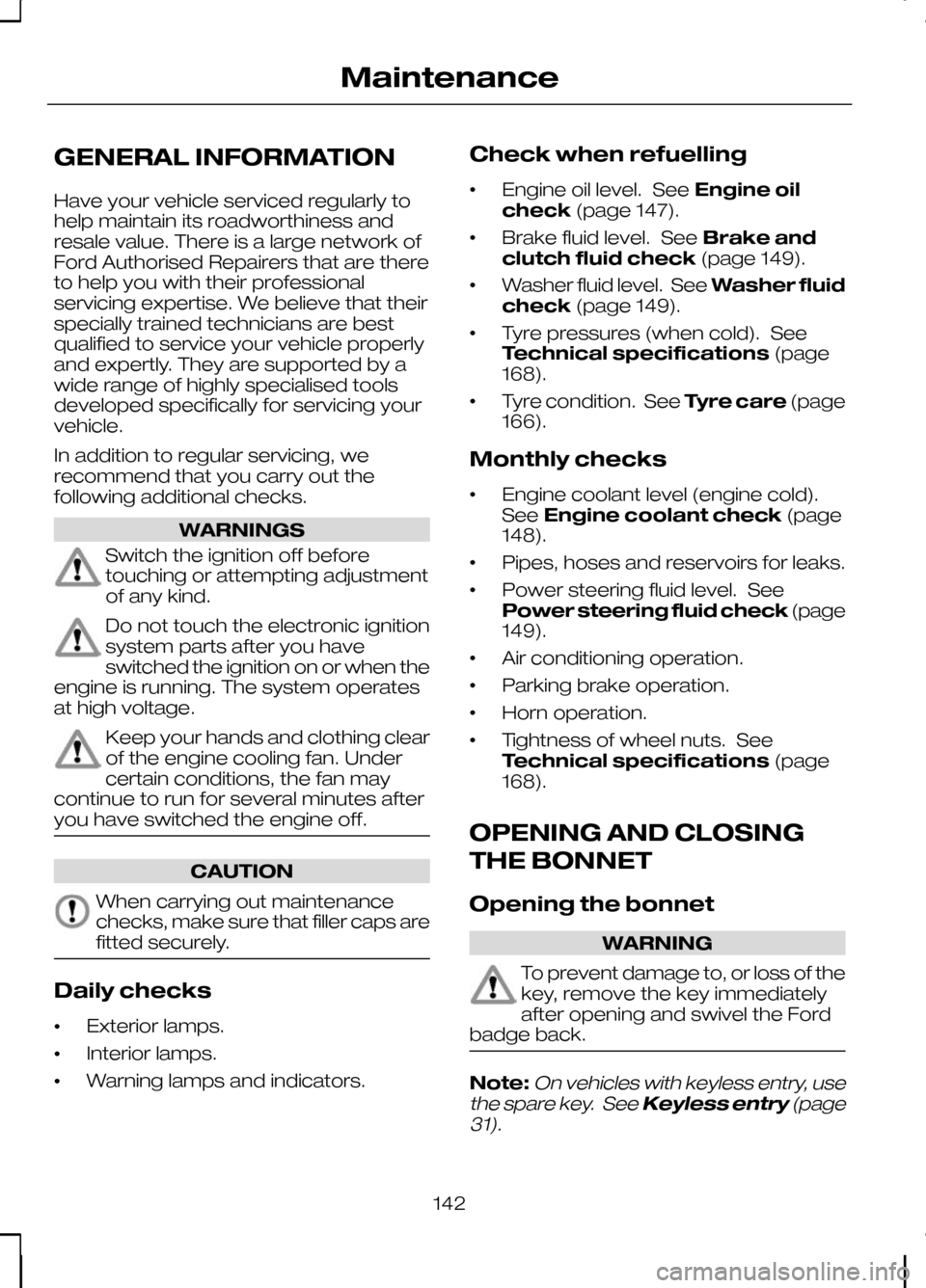
GENERAL INFORMATION
Have your vehicle serviced regularly to
help maintain its roadworthiness and
resale value. There is a large network of
Ford Authorised Repairers that are there
to help you with their professional
servicing expertise. We believe that their
specially trained technicians are best
qualified to service your vehicle properly
and expertly. They are supported by a
wide range of highly specialised tools
developed specifically for servicing your
vehicle.
In addition to regular servicing, we
recommend that you carry out the
following additional checks.
WARNINGS
Switch the ignition off before
touching or attempting adjustment
of any kind.
Do not touch the electronic ignition
system parts after you have
switched the ignition on or when the
engine is running. The system operates
at high voltage. Keep your hands and clothing clear
of the engine cooling fan. Under
certain conditions, the fan may
continue to run for several minutes after
you have switched the engine off. CAUTION
When carrying out maintenance
checks, make sure that filler caps are
fitted securely.
Daily checks
•
Exterior lamps.
• Interior lamps.
• Warning lamps and indicators. Check when refuelling
•
Engine oil level. See
Engine oil
check (page 147).
• Brake fluid level. See
Brake and
clutch fluid check (page 149).
• Washer fluid level. See
Washer fluid
check (page 149).
• Tyre pressures (when cold). See
Technical specifications
(page
168).
• Tyre condition. See
Tyre care(page
166).
Monthly checks
• Engine coolant level (engine cold).
See
Engine coolant check (page
148).
• Pipes, hoses and reservoirs for leaks.
• Power steering fluid level. See
Power steering fluid check
(page
149).
• Air conditioning operation.
• Parking brake operation.
• Horn operation.
• Tightness of wheel nuts. See
Technical specifications
(page
168).
OPENING AND CLOSING
THE BONNET
Opening the bonnet WARNING
To prevent damage to, or loss of the
key, remove the key immediately
after opening and swivel the Ford
badge back. Note:On vehicles with keyless entry, use
the spare key. See Keyless entry(page
31).
142
Maintenance
Page 145 of 226
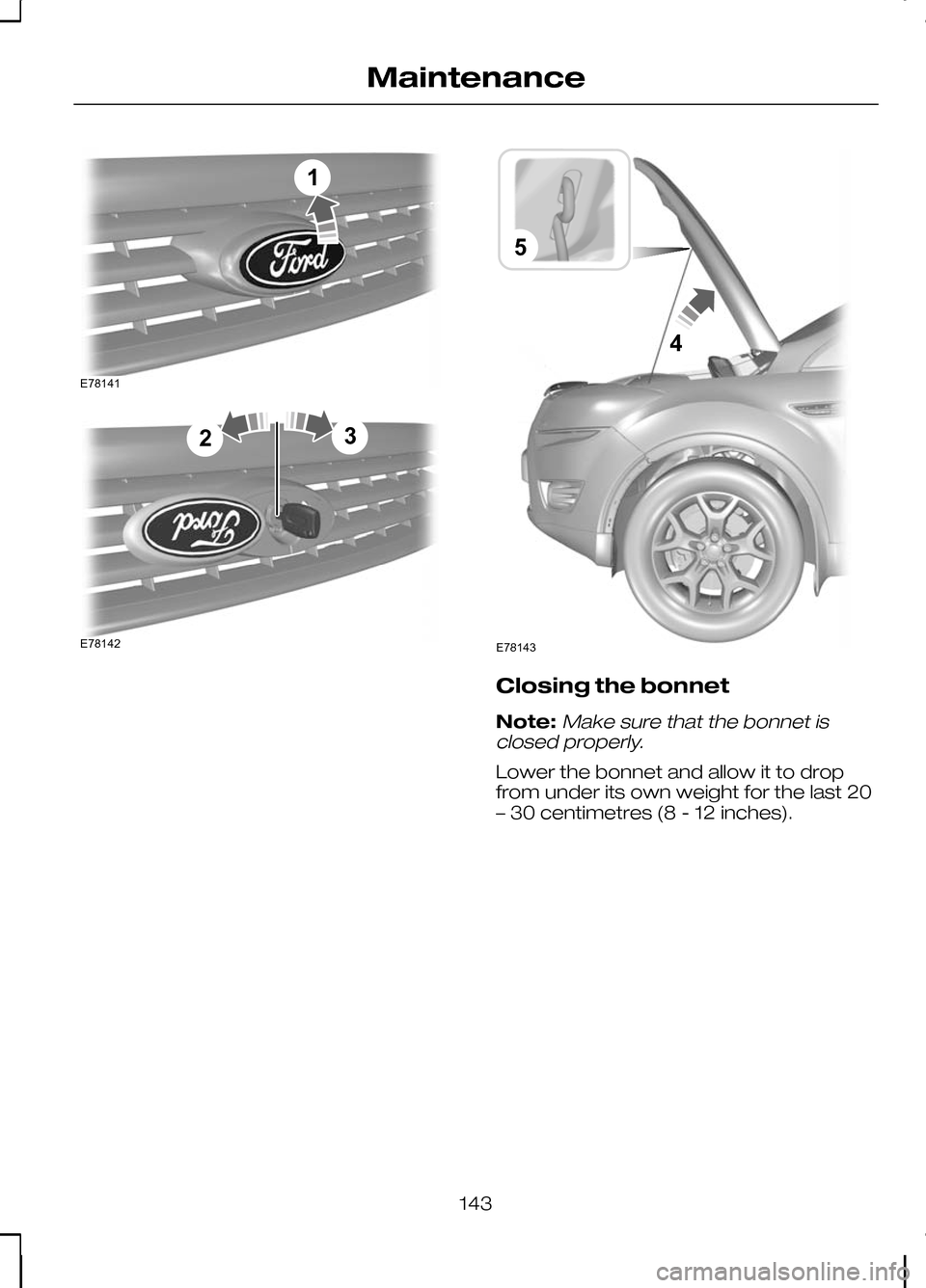
Closing the bonnet
Note:Make sure that the bonnet is
closed properly.
Lower the bonnet and allow it to drop
from under its own weight for the last 20
– 30 centimetres (8 - 12 inches).
143
Maintenance1E78141 E7814223 54E78143
Page 146 of 226
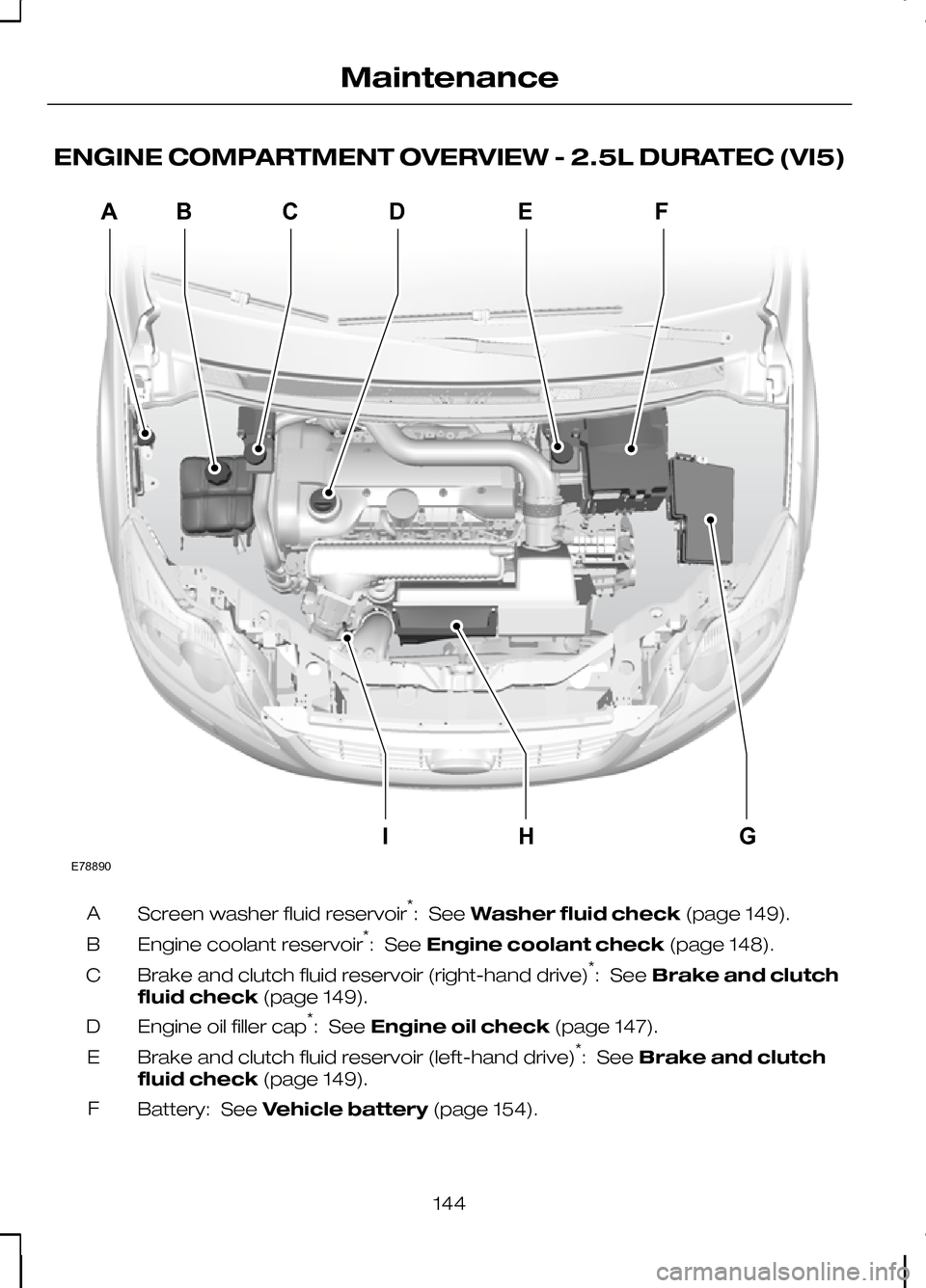
ENGINE COMPARTMENT OVERVIEW - 2.5L DURATEC (VI5)
Screen washer fluid reservoir
*
: See Washer fluid check (page 149).
A
Engine coolant reservoir *
: See Engine coolant check (page 148).
B
Brake and clutch fluid reservoir (right-hand drive) *
: See Brake and clutch
fluid check (page 149).
C
Engine oil filler cap *
: See Engine oil check (page 147).
D
Brake and clutch fluid reservoir (left-hand drive) *
: See Brake and clutch
fluid check (page 149).
E
Battery: See Vehicle battery (page 154).
F
144
MaintenanceE78890IFEDCBAHG
Page 147 of 226
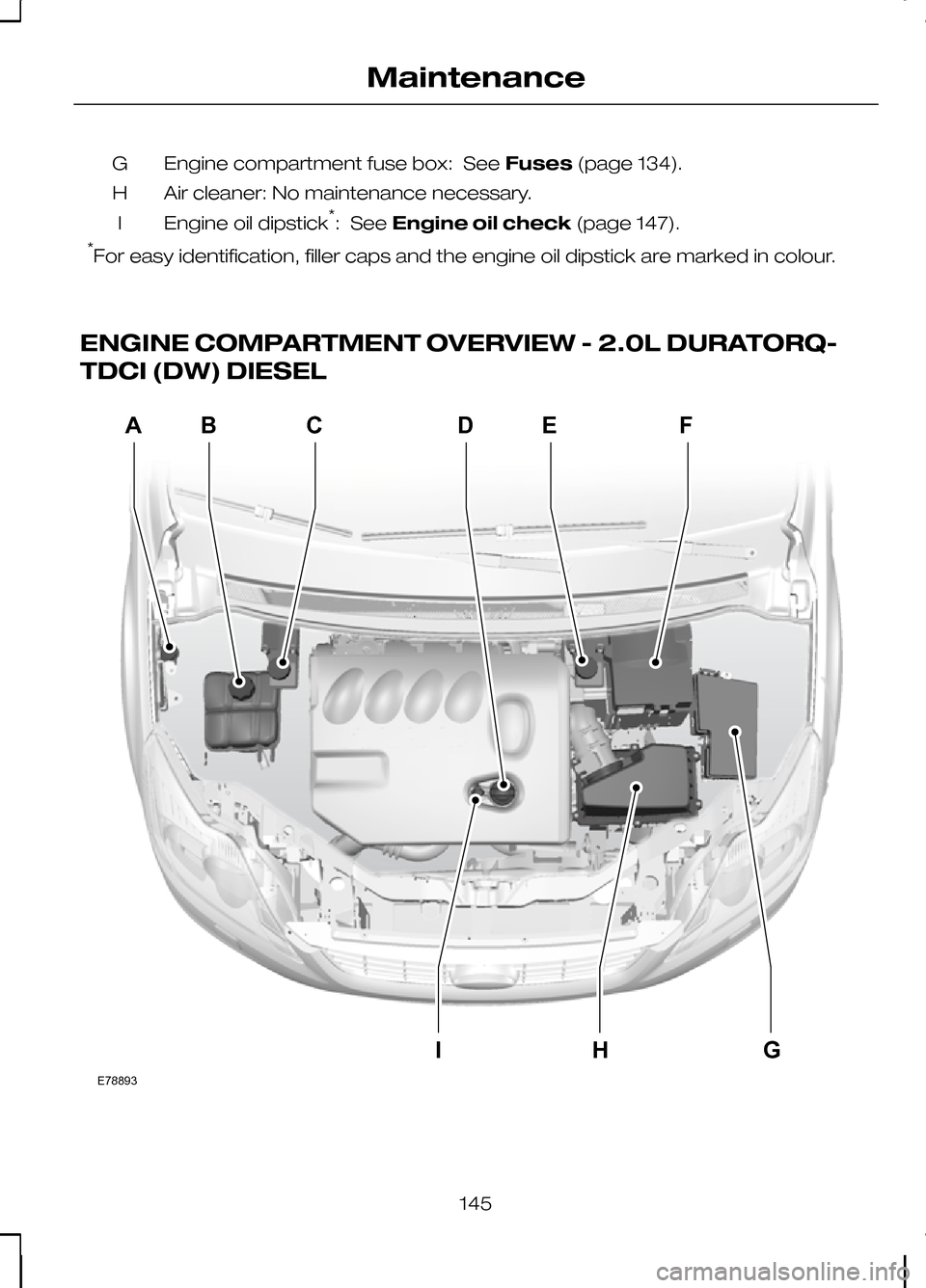
Engine compartment fuse box: See
Fuses(page 134).
G
Air cleaner: No maintenance necessary.
H
Engine oil dipstick *
: See Engine oil check (page 147).
I
* For easy identification, filler caps and the engine oil dipstick are marked in colour.
ENGINE COMPARTMENT OVERVIEW - 2.0L DURATORQ-
TDCI (DW) DIESEL 145
MaintenanceE78893IFEDCBAHG
Page 148 of 226
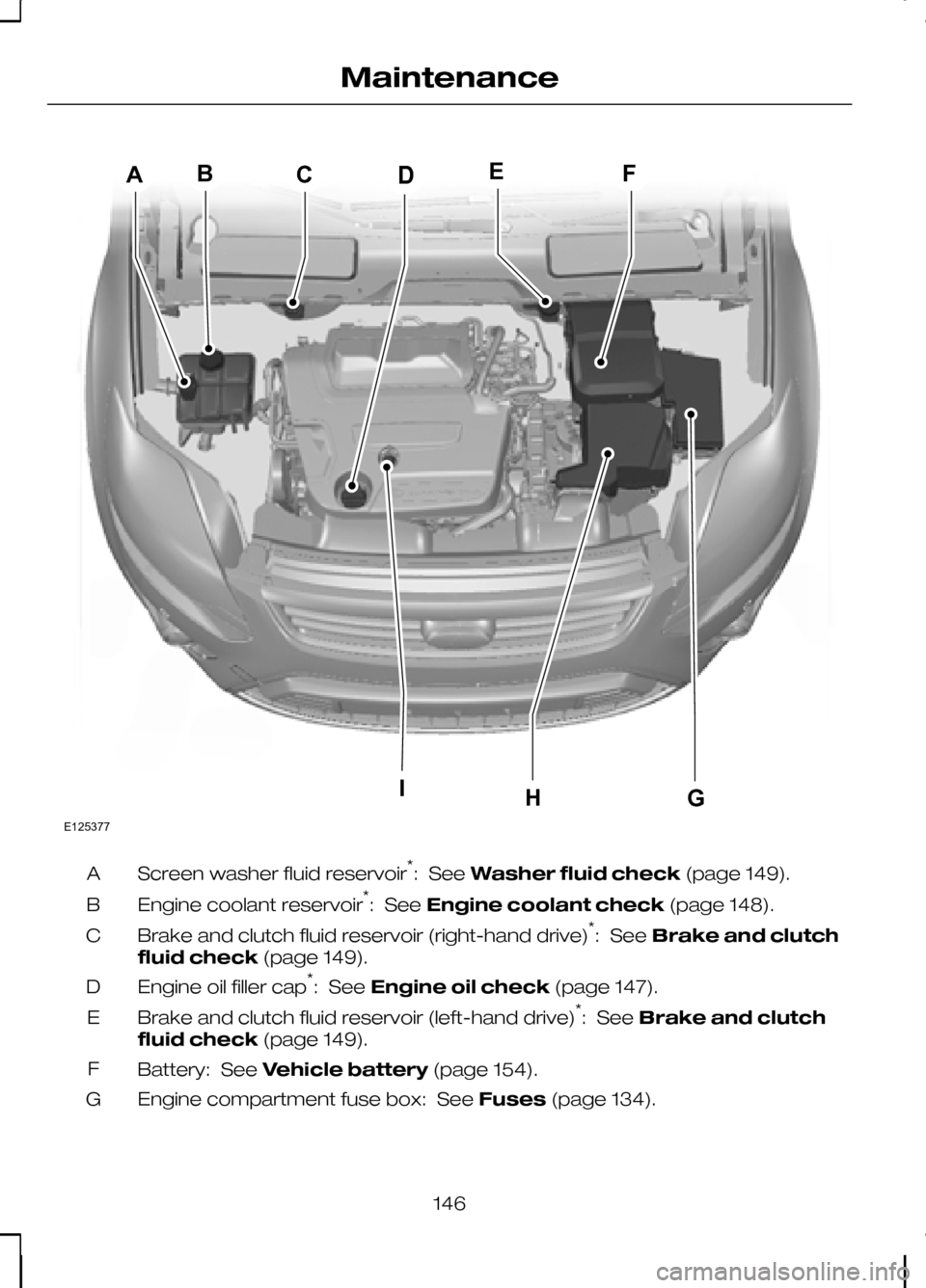
Screen washer fluid reservoir
*
: See Washer fluid check (page 149).
A
Engine coolant reservoir *
: See Engine coolant check (page 148).
B
Brake and clutch fluid reservoir (right-hand drive) *
: See Brake and clutch
fluid check (page 149).
C
Engine oil filler cap *
: See Engine oil check (page 147).
D
Brake and clutch fluid reservoir (left-hand drive) *
: See Brake and clutch
fluid check (page 149).
E
Battery: See Vehicle battery (page 154).
F
Engine compartment fuse box: See Fuses(page 134).
G
146
MaintenanceIFEDCBAHGE125377
Page 149 of 226
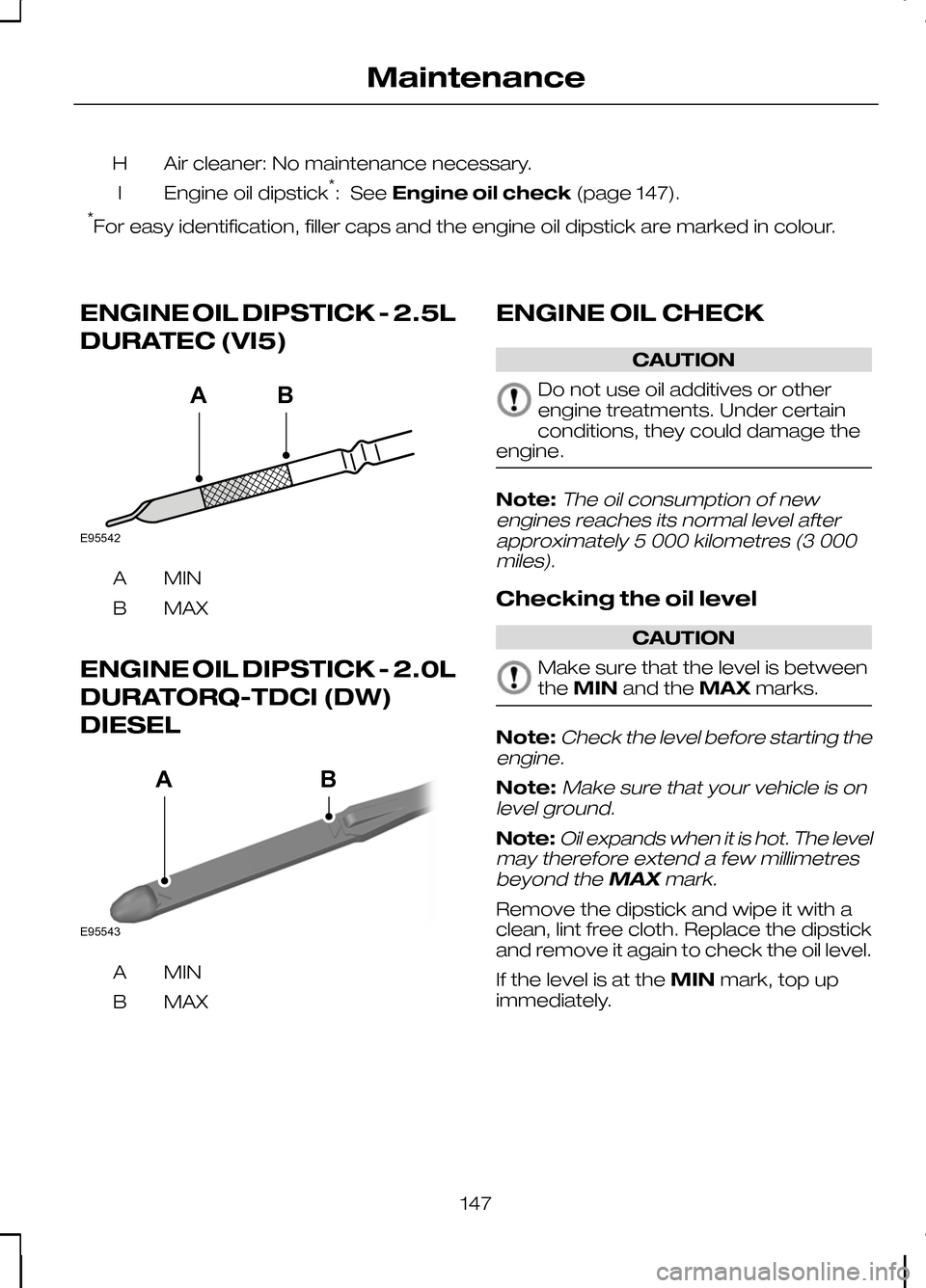
Air cleaner: No maintenance necessary.
H
Engine oil dipstick *
: See Engine oil check (page 147).
I
* For easy identification, filler caps and the engine oil dipstick are marked in colour.
ENGINE OIL DIPSTICK - 2.5L
DURATEC (VI5) MINA
MAX
B
ENGINE OIL DIPSTICK - 2.0L
DURATORQ-TDCI (DW)
DIESEL MINA
MAX
B ENGINE OIL CHECK CAUTION
Do not use oil additives or other
engine treatments. Under certain
conditions, they could damage the
engine. Note:The oil consumption of new
engines reaches its normal level after approximately 5 000 kilometres (3 000miles).
Checking the oil level CAUTION
Make sure that the level is between
the
MIN and the MAXmarks. Note:
Check the level before starting the
engine.
Note:Make sure that your vehicle is on
level ground.
Note:Oil expands when it is hot. The level
may therefore extend a few millimetres
beyond the MAXmark.
Remove the dipstick and wipe it with a
clean, lint free cloth. Replace the dipstick
and remove it again to check the oil level.
If the level is at the MINmark, top up
immediately.
147
MaintenanceE95542BA E95543BA
Page 150 of 226
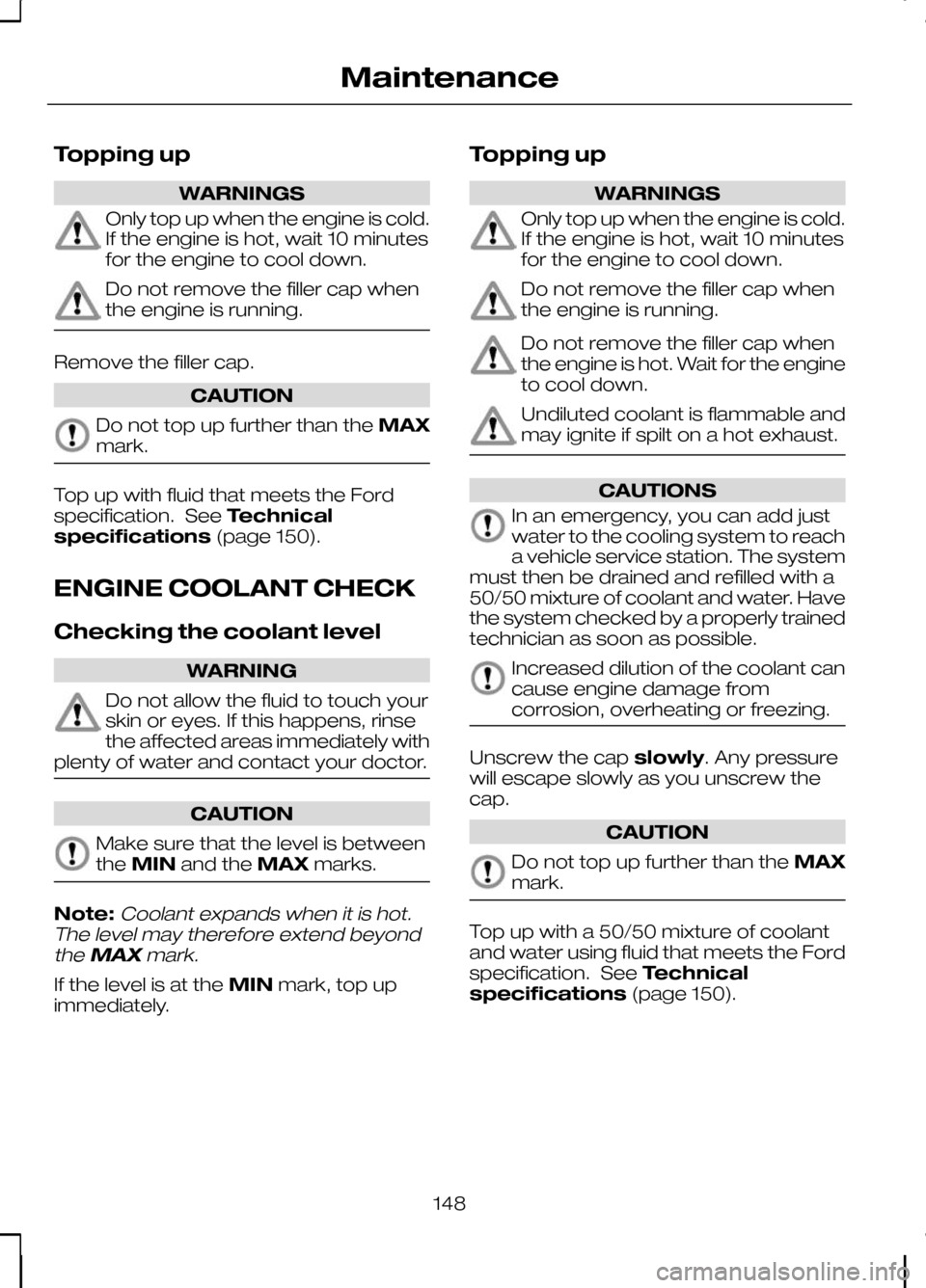
Topping up
WARNINGS
Only top up when the engine is cold.
If the engine is hot, wait 10 minutes
for the engine to cool down.
Do not remove the filler cap when
the engine is running.
Remove the filler cap.
CAUTION
Do not top up further than the
MAX
mark. Top up with fluid that meets the Ford
specification. See
Technical
specifications (page 150).
ENGINE COOLANT CHECK
Checking the coolant level WARNING
Do not allow the fluid to touch your
skin or eyes. If this happens, rinse
the affected areas immediately with
plenty of water and contact your doctor. CAUTION
Make sure that the level is between
the
MIN and the MAXmarks.Note:Coolant expands when it is hot.
The level may therefore extend beyond
the MAX mark.
If the level is at the MINmark, top up
immediately. Topping up WARNINGS
Only top up when the engine is cold.
If the engine is hot, wait 10 minutes
for the engine to cool down.
Do not remove the filler cap when
the engine is running.
Do not remove the filler cap when
the engine is hot. Wait for the engine
to cool down.
Undiluted coolant is flammable and
may ignite if spilt on a hot exhaust.
CAUTIONS
In an emergency, you can add just
water to the cooling system to reach
a vehicle service station. The system
must then be drained and refilled with a
50/50 mixture of coolant and water. Have
the system checked by a properly trained
technician as soon as possible. Increased dilution of the coolant can
cause engine damage from
corrosion, overheating or freezing.
Unscrew the cap
slowly. Any pressure
will escape slowly as you unscrew the
cap. CAUTION
Do not top up further than the
MAX
mark. Top up with a 50/50 mixture of coolant
and water using fluid that meets the Ford
specification. See
Technical
specifications (page 150).
148
Maintenance